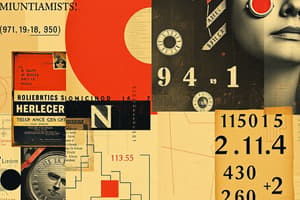Podcast
Questions and Answers
How many significant figures are in the number 0.00540?
How many significant figures are in the number 0.00540?
- 5
- 3 (correct)
- 2
- 4
Which of the following numbers has the least significant figures?
Which of the following numbers has the least significant figures?
- 50.00
- 123.45
- 0.0450
- 2000 (correct)
What is the correct rounding result of 4.678 to three significant figures?
What is the correct rounding result of 4.678 to three significant figures?
- 4.75
- 4.67
- 4.68
- 4.70 (correct)
When performing addition with the numbers 12.11, 0.2, and 0.022, what should be the decimal places of the final result?
When performing addition with the numbers 12.11, 0.2, and 0.022, what should be the decimal places of the final result?
In which scenario would you round your answer to the least number of significant figures?
In which scenario would you round your answer to the least number of significant figures?
Which error commonly leads to miscounting significant figures?
Which error commonly leads to miscounting significant figures?
What is the result of 6.25 multiplied by 3.1, rounded to the correct number of significant figures?
What is the result of 6.25 multiplied by 3.1, rounded to the correct number of significant figures?
How should the result of 1500 + 0.25 be rounded?
How should the result of 1500 + 0.25 be rounded?
Flashcards are hidden until you start studying
Study Notes
Rules of Significant Figures
- Definition: Significant figures are the digits in a number that contribute to its precision.
- Identifying Significant Figures:
- All non-zero digits are significant (e.g., 123 has three significant figures).
- Any zeros between significant digits are significant (e.g., 1002 has four significant figures).
- Leading zeros are not significant (e.g., 0.0045 has two significant figures).
- Trailing zeros in a number with a decimal point are significant (e.g., 2.300 has four significant figures).
- Trailing zeros in a whole number without a decimal point are not significant (e.g., 1500 has two significant figures unless specified).
Rounding and Estimating
- Rounding Rules:
- If the digit to be dropped is less than 5, the last retained digit remains unchanged (e.g., 2.34 → 2.3).
- If the digit to be dropped is 5 or greater, increase the last retained digit by one (e.g., 2.36 → 2.4).
- Estimating:
- Use significant figures to estimate results based on the precision of measured values, ensuring that results reflect the significant figures of the least precise measurement.
Applications in Measurements
- Precision vs. Accuracy: Significant figures indicate precision in measurement, while accuracy refers to how close a measurement is to the true value.
- Calculations:
- Addition/Subtraction: Round the answer to the least number of decimal places of any number in the operation.
- Multiplication/Division: Round the answer to the least number of significant figures of any number in the operation.
Common Errors in Significant Figures
- Miscounting significant figures: Failing to recognize significant digits, especially with zeros.
- Ignoring decimal places in addition/subtraction: Incorrectly rounding based on significant figures rather than decimal places.
- Inconsistent application: Using different rules for different calculations leading to confusion in reporting results.
- Overlooking trailing zeros: Not distinguishing between significant and non-significant trailing zeros in whole numbers.
Rules of Significant Figures
- Significant figures contribute to the precision of a number.
- Non-zero digits are always significant.
- Zeros between significant digits are considered significant.
- Leading zeros do not count as significant figures.
- Trailing zeros are significant only if there’s a decimal point in the number.
- Whole numbers without a decimal point may have trailing zeros that are not significant unless specified.
Rounding and Estimating
- Rounding rules state that:
- Dropping a digit less than 5 keeps the last retained digit unchanged.
- Dropping a digit of 5 or greater increases the last retained digit by one.
- Estimating results should reflect the precision of the least precise measurement, aligning outcomes with significant figures.
Applications in Measurements
- Precision reflects the number of significant figures, while accuracy measures closeness to the true value.
- For addition and subtraction, the result should be rounded to match the least number of decimal places among the values used.
- In multiplication and division, round the result to the least number of significant figures present in any measurement involved.
Common Errors in Significant Figures
- Miscounting significant figures often occurs due to overlooked zeros.
- In addition and subtraction, errors arise from rounding based on significant figures instead of decimal places.
- Inconsistent application of rules can confuse result reporting.
- Trailing zeros in whole numbers might be overlooked, affecting the identification of significant figures.
Studying That Suits You
Use AI to generate personalized quizzes and flashcards to suit your learning preferences.




